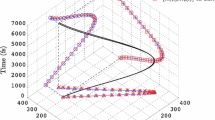Abstract
The quantum theory of relativistic particles is developed in close analogy with that of nonrelativistic ones. In §1 we show how the Hilbert-space for the states of a physical system can be derived immediaty from experience. It turns out that both theories, the relativistic as well as the nonrelativistic one belong to the same Hilbert space. Lorentz invariance does not enter until we consider the transformations induced in the Hilbert space by the motion of the particles. These are formulated in §2. They form a representation of the inhomogeneous Lorentz-group or even of the Klein-group of conformai transformations in space-time.
In §3 we develop the Hilbert-space from the so called “basic space”. This space is spanned by simultaneously observable quantities of specific single particles which we call ‘simple particles’. The characteristics of these single particles are: particle type (mass), momentum, spin, isotopic spin, etc. The configuration-space of a many particle system is taken as a set of all occupation numbers in the basic space. The Hilbert space is then the manifold of all square-integrable functions in the configuration space.
In this paper the simple particles are considered to have zero rest-mass. Those having finite mass require the assumption of internal interactions and thus lead to complex structures. Mereover, particles of mass zero are distinguished by a higher degree of symmetry, i.e. by their invariance under transformations of the Klein-group. Taking into account further group-theoretical properties of the Klein-group, we assume that all aprticles are built up from neutrinos of two types. Only these we consider as simple particles.
To begin with, we consider the simple case of a world with one kind of simple particles having no internal degrees of freedom. In §4 operators are given representing the inhomogeneous Lorentz-group and the Klein-group. For particles without any interaction these can easily be determined. In the case of particles with interaction it is possible to derive all operators of the inhomogeneous Lorentz-group from the interaction energy operator. This operator must satisfy certain conditions, one of which is quite involved and leads to a nonlinear operator equation. A special and rather simple approximate solution is given in §5. The resulting two-body-equation given in §6 leads to some interesting features concerning scattering and virtual and bound states. The cross-section and the wave function of the virtual state of the particle-pair, as well as the mass of a resonant state are finite. There is no bound state after a limiting process. The whole is strictly Lorentz-invariant, although we started from an expression only approximately Lorentz-invariant.
Finally we state the corresponding field equations in §7. Our specific expression for the interaction energy leads to a strictly local coupling between the particles.
However, the kinetic terms (which are bilinear in creation- and annihilation-operators) are of a non-local type, perhaps describing something like an interaction between the particles and the vacuum.
Similar content being viewed by others
Author information
Authors and Affiliations
Additional information
Max Born zum 80. Geburtstag in Dankbarkeit zugeeignet.
Rights and permissions
About this article
Cite this article
Bopp, F. Zur Quantenmechanik relativistischer Teilchen bei gegebenem Hilbert-Raum. Z. Physik 171, 90–115 (1963). https://doi.org/10.1007/BF01379340
Received:
Issue Date:
DOI: https://doi.org/10.1007/BF01379340




